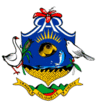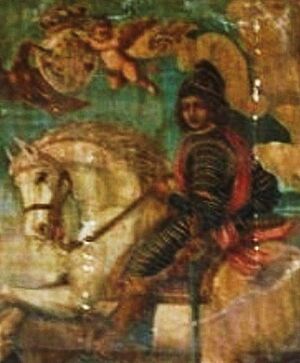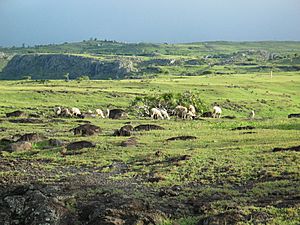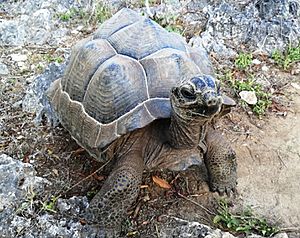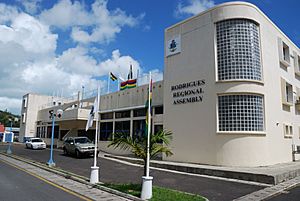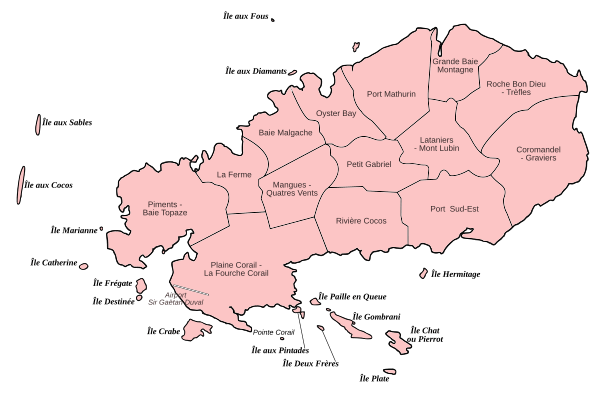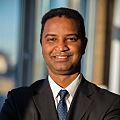Rodrigues facts for kids
Quick facts for kids
Rodrigues
Rodrig (Morisyen)
|
|||
|---|---|---|---|
|
Autonomous outer island
|
|||
|
|||
| Motto(s): | |||
| Anthem: Motherland | |||

Location of Rodrigues in the Indian Ocean.
|
|||
| Country | |||
| Capital | Port Mathurin | ||
| Government | |||
| • Body | Regional Assembly | ||
| Area | |||
| • Total | 108 km2 (42 sq mi) | ||
| Population
(2014)
|
|||
| • Total | 41,669 | ||
| • Estimate
(2013)
|
38,379 | ||
| • Density | 386/km2 (1,000/sq mi) | ||
| Demonym(s) | Rodriguan | ||
| Languages | |||
| • Vernacular languages |
|
||
| Time zone | UTC+4 (MUT) | ||
| Calling code | +230 | ||
| Currency | Mauritian rupee (MUR) | ||
| Date format | dd/mm/yyyy (AD) | ||
| Drives on | left | ||
| Internet TLD | .mu | ||
Rodrigues (in French: Île Rodrigues, in Creole: Rodrig) is a special island that governs itself. It is part of the Republic of Mauritius in the Indian Ocean. The island is about 108 square kilometers (42 square miles) and lies about 560 kilometers (350 miles) east of Mauritius.
Rodrigues is part of the Mascarene Islands, which also include Mauritius and Réunion. It was formed by volcanoes and has a beautiful coral reef around it. There are also many tiny, uninhabited islands near its coast. Rodrigues used to be the tenth district of Mauritius. It became self-governing on December 10, 2002. The island is now run by its own local government, the Rodrigues Regional Assembly. The main town and capital of the island is Port Mathurin.
The people living on Rodrigues are citizens of Mauritius. In 2014, about 41,669 people lived there. Most of them are of African descent. The island's economy mainly relies on fishing, farming, making handicrafts, and a growing tourism industry.
Rodrigues, along with two other islands called Agaléga and Saint Brandon, makes up the larger country of Mauritius. The President of Mauritius is the head of the country. The Chief Commissioner of Rodrigues is the head of the island's local government.
Contents
- Island History: How Rodrigues Got Its Name
- Geography: Exploring Rodrigues' Landscape
- Government and Politics: How Rodrigues Is Run
- Demographics: People and Culture
- Education: Learning on the Island
- Transportation: Getting Around Rodrigues
- Economy: How Rodrigues Makes Money
- Culture: Music, Food, and Sports
- Images for kids
- See also
Island History: How Rodrigues Got Its Name
The island of Rodrigues was empty when the Portuguese explorer Diogo Rodrigues found it in February 1528. He named it after himself. On many old maps, the island was also called Diego Roiz.
Arab people visited the Mascarene Islands as early as the 10th century. A map from the 12th century by an Arab geographer might show these islands. Later maps from around 1500 clearly show the three Mascarene islands. They were called Dina Arobi, Dina Margabin, and Dina Moraze. These names likely came from Arabic words meaning "Desert Island," "Western Island," and "Eastern Island."
The island was found again in February 1507 by a Portuguese fleet. Their ship, the Cirne, saw Réunion first. Then they found the other two islands. Rodrigues was first called Diogo Fernandes. Later, it was called Domingo Froiz. By 1528, it was officially named after Diogo Rodrigues, and the name has stayed since then.
For a long time, not many ships visited Rodrigues because it was far from common sea routes. Starting in 1601, Dutch ships began to visit more often to get fresh food supplies. In 1691, a group of eight French Protestants, led by François Leguat, came to the island. They wanted to start a farming community. Farming was hard, but they found lots of tortoises, turtles, birds, and fish.
In the 1700s, the French tried to develop the island. They brought enslaved people from Africa to help with farming and raising animals. These enslaved people are the ancestors of many people living on Rodrigues today. In 1735, the French set up a permanent settlement on the island.
In 1809, after a short fight with the French, British troops took control of Rodrigues. Slavery was later ended in 1834. By 1843, the island's population had dropped to only 250 people.
In 1883, the huge eruption of the Krakatoa volcano in Indonesia was heard on Rodrigues Island. This was almost 4,800 kilometers (3,000 miles) away! People described the sound as "the roar of heavy guns." Naval ships were sent to check, as it was thought to be a ship in trouble. This remains one of the loudest sounds ever recorded.
In 1968, Rodrigues became part of Mauritius when Mauritius gained its independence. In 2002, Rodrigues became an autonomous region of Mauritius. This means it has its own local government.
In 1997, a 40-foot (12-meter) Russian yacht called Admiral Nevelskoi was found in the lagoon of Rodrigues. It had been abandoned at sea for over two years after its mast and rudder broke. The yacht was later brought ashore and turned into a maritime museum. This museum shows the only link Russia has to the Indian Ocean.
Geography: Exploring Rodrigues' Landscape
Rodrigues is an island formed by volcanoes. It sits on a ridge at the edge of the Mascarene Plateau. The island is quite young, only about 1.5 million years old. Over time, Rodrigues has developed a special environment with many unique plants and animals found nowhere else.
Rodrigues is about 560 kilometers (350 miles) east of Mauritius. It is about 18 kilometers (11 miles) long and 6.5 kilometers (4 miles) wide. Its total area is 108 square kilometers (42 square miles). The island is hilly, with a central ridge. The highest point is Mountain Limon, which is 398 meters (1,306 feet) tall. Rodrigues is the only Mascarene island with large amounts of limestone and caves. A big coral reef surrounds the island, forming a lagoon with eighteen small islets inside it.
The coral reef around Rodrigues is special because it grows on its own. It does not get coral larvae from other places. This has led to an ecosystem with fewer species, but those species are very well-adapted to this unique environment. Some types of coral, two kinds of damselfish, and many types of crabs and other crustaceans are found only on Rodrigues' reefs.
Climate: Weather on Rodrigues
Rodrigues has its own special climate because of its isolated location. It has two main seasons. The island enjoys a mild tropical climate with steady trade winds blowing all year. The average summer temperature is about 25.9°C (78.6°F). The average winter temperature is around 22.3°C (72.1°F). The hottest months are January to March, and August is the coolest. February is the wettest month, while September and October are the driest. The climate here is hotter and drier than in Mauritius. Tropical cyclones can happen from November to April, and Rodrigues is hit by them more often than Mauritius.
| Climate data for Rodrigues | |||||||||||||
|---|---|---|---|---|---|---|---|---|---|---|---|---|---|
| Month | Jan | Feb | Mar | Apr | May | Jun | Jul | Aug | Sep | Oct | Nov | Dec | Year |
| Record high °C (°F) | 33.9 (93.0) |
34.0 (93.2) |
33.9 (93.0) |
33.0 (91.4) |
30.9 (87.6) |
30.9 (87.6) |
30.4 (86.7) |
31.2 (88.2) |
30.7 (87.3) |
30.9 (87.6) |
30.9 (87.6) |
33.1 (91.6) |
34.0 (93.2) |
| Mean daily maximum °C (°F) | 29.2 (84.6) |
29.3 (84.7) |
29.4 (84.9) |
28.7 (83.7) |
27.5 (81.5) |
26.0 (78.8) |
25.0 (77.0) |
24.8 (76.6) |
25.4 (77.7) |
26.3 (79.3) |
27.4 (81.3) |
28.7 (83.7) |
27.3 (81.1) |
| Mean daily minimum °C (°F) | 23.6 (74.5) |
23.8 (74.8) |
23.7 (74.7) |
23.0 (73.4) |
21.6 (70.9) |
20.1 (68.2) |
19.1 (66.4) |
18.8 (65.8) |
19.3 (66.7) |
20.1 (68.2) |
21.3 (70.3) |
22.8 (73.0) |
21.4 (70.5) |
| Record low °C (°F) | 18.4 (65.1) |
19.8 (67.6) |
19.0 (66.2) |
18.4 (65.1) |
18.1 (64.6) |
16.5 (61.7) |
14.5 (58.1) |
15.2 (59.4) |
15.8 (60.4) |
16.5 (61.7) |
17.2 (63.0) |
19.2 (66.6) |
14.5 (58.1) |
| Average precipitation mm (inches) | 150.0 (5.91) |
184.7 (7.27) |
131.2 (5.17) |
117.0 (4.61) |
78.3 (3.08) |
77.6 (3.06) |
80.8 (3.18) |
59.4 (2.34) |
43.8 (1.72) |
40.7 (1.60) |
70.0 (2.76) |
71.0 (2.80) |
1,104.5 (43.48) |
| Average precipitation days (≥ 1.0 mm) | 12 | 13 | 13 | 13 | 12 | 13 | 15 | 13 | 9 | 8 | 7 | 8 | 136 |
| Average relative humidity (%) | 79 | 81 | 80 | 79 | 75 | 74 | 75 | 74 | 74 | 74 | 76 | 77 | 76 |
| Mean monthly sunshine hours | 275.9 | 240.1 | 257.3 | 243.0 | 244.9 | 219.0 | 232.5 | 244.9 | 237.0 | 275.9 | 273.0 | 285.2 | 3,028.7 |
| Mean daily sunshine hours | 8.9 | 8.5 | 8.3 | 8.1 | 7.9 | 7.3 | 7.5 | 7.9 | 7.9 | 8.9 | 9.1 | 9.2 | 8.9 |
| Source: Mauritius Meteorological Services | |||||||||||||
Biodiversity: Unique Animals and Plants
Rodrigues used to have many unique plants and animals found only there. However, since the 1600s, much of this special nature has been lost. The island was once home to a flightless bird called the Rodrigues solitaire, which is now extinct.
An endemic bat species, the Rodrigues flying fox, is currently listed as endangered. This means it is at high risk of disappearing forever. There are two other bird species found only on Rodrigues: the Rodrigues fody and the Rodrigues warbler. Both are considered "near threatened," meaning they could become endangered soon.
To help protect nature, some areas have been made into nature reserves. These include Grande Montagne Nature Reserve, Anse Quitor Nature Reserve (which is next to the François Leguat Giant Tortoise and Cave Reserve), and two small islands, Île aux Sables and Île aux Cocos. These reserves protect endangered plants like Zanthoxylum paniculatum and Polyscias rodriguesiana.
Government and Politics: How Rodrigues Is Run
Rodrigues is part of the Republic of Mauritius. However, it has its own special self-governing system. In 2001, the National Assembly of Mauritius passed laws to give Rodrigues more control over its own affairs.
This new system created a regional assembly in Rodrigues with 18 members. It also has an executive council led by a Chief Commissioner. This council meets every week to make decisions, create local laws, and manage the island's money. The Chief Commissioner's main job is to keep the Mauritian Prime Minister informed about what is happening on the island.
The most recent election for the Rodrigues Regional Assembly was on February 12, 2017. The Organisation du Peuple de Rodrigues (OPR) party won ten seats. The Mouvement Rodriguais (MR) party won seven seats. The current Chief Commissioner is Louis Serge Clair. The Chief Executive of Rodrigues is Davis Hee Hong Wye.
Electoral Regions: Voting Areas
The island is divided into six areas for elections:
- La Ferme (Region 1)
- Marechal (Region 2)
- Saint Gabriel (Region 3)
- Baie aux Huitres (Region 4)
- Port Mathurin (Region 5)
- Grande Montagne (Region 6)
Elections for the Rodrigues Regional Assembly happen every five years.
Zones: Local Areas
Rodrigues is also divided into 14 smaller areas called municipalities or zones. For counting people and other statistics, these zones are further split into 182 smaller places called localities. Some zones have few localities, like La Ferme with six. Others, like the capital Port Mathurin, have many, up to 22.
| Zone Nr. | Municipality | Population |
|---|---|---|
| 05 Zone 5 | Port Mathurin | 5,929 |
| 08 Zone 8 | Lataniers-Mont Lubin | 3,806 |
| 09 Zone 9 | Petit Gabriel | 3,658 |
| 12 Zone 12 | Rivière Cocos | 2,893 |
| 10 Zone 10 | Mangues-Quatre Vents | 2,870 |
| 11 Zone 11 | Plaine Corail-La Fouche Corail | 2,832 |
| 13 Zone 13 | Port Sud-Est | 2,717 |
| 04 Zone 4 | Oyster Bay | 2,594 |
| 07 Zone 7 | Roche Bon Dieu-Trèfles | 2,059 |
| 14 Zone 14 | Coromandel-Graviers | 1,944 |
| 01 Zone 1 | Piments-Baie Topaze | 1,445 |
| 02 Zone 2 | La Ferme | 1,112 |
| 03 Zone 3 | Baie Malgache | 1,076 |
| 06 Zone 6 | Grand Baie-Montagne Goyaves | 844 |
| Rodrigues | 35,779 |
Demographics: People and Culture
As of December 24, 2012, the population of Rodrigues was about 39,242 people. Most people on the island are Christian, mainly Roman Catholic. There are also smaller groups of other Christians, Jehovah's Witnesses, Hindus, Muslims, and Buddhists. Most of the people living on Rodrigues are of African descent. There is also a smaller group of people with mixed ancestry, who are descendants of the first European settlers.
The main language spoken is Rodriguan Creole. However, English and French are used for government, courts, and business. Rodriguan Creole is very similar to Mauritian Creole, but some words are said differently. People born on Rodrigues island are called Rodriguans.
Education: Learning on the Island
The education system in Rodrigues is like the one in the rest of Mauritius. The government provides free education for students up to college level. Most subjects are taught in English.
Transportation: Getting Around Rodrigues
Rodrigues has an airport called Sir Gaëtan Duval Airport in Plane Corail. There are regular flights from this airport to Sir Seewoosagur Ramgoolam International Airport in Plaisance, Mauritius.
Economy: How Rodrigues Makes Money
The economy of Rodrigues mostly depends on Mauritius. The main ways people earn money and the main activities are tourism, fishing, and farming. Farmers grow things like onions, garlic, and chili peppers. Raising animals is also important. The industry of making handicrafts has been good for the island's economy.
However, Rodrigues spends more money on imported goods than it earns from selling its own products like seafood, cattle, and crops. This creates a trade deficit. Rodrigues also has a special connection with English-speaking countries like the United Kingdom, Australia, and Ireland.
Culture: Music, Food, and Sports
Music and Folklore: The Sounds of Rodrigues
The traditional music of Rodrigues is called Sega Tambour. This music has a strong beat and is usually played with an accordion. People also clap and use simple instruments made from things like bamboo. The folk dances are similar to polkas, quadrilles, waltzes, and Scottish reels.
Cuisine: Delicious Food of Rodrigues
Rodrigues cuisine uses local ingredients like fruits, vegetables, seafood, and meat. Seafood includes fish, octopus, crab, shrimp, and lobster. Some popular dishes are sausages with kreolinės, rougaille sauce, octopus with curry, kono-kono (a type of shellfish) salad, and Rodrigues cake.
Sports: Staying Active
The most popular sport in Rodrigues is football. There are local competitions almost all year. Winning teams sometimes travel to Mauritius for sports exchanges. Volleyball is also a popular sport. The island has a public swimming pool in Marechal and a stadium in Camp Du Rois, near Port Mathurin.
Images for kids
See also
 In Spanish: Isla Rodrigues para niños
In Spanish: Isla Rodrigues para niños



